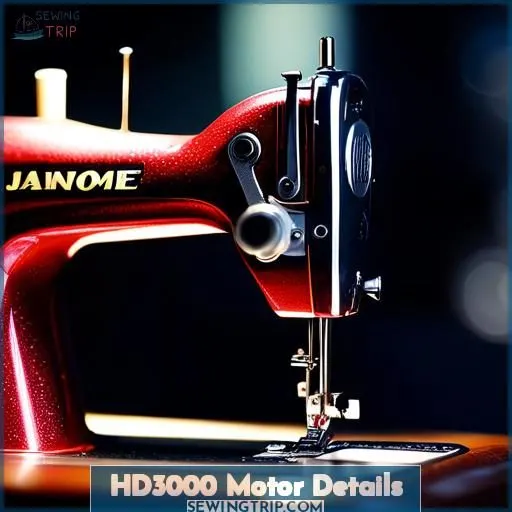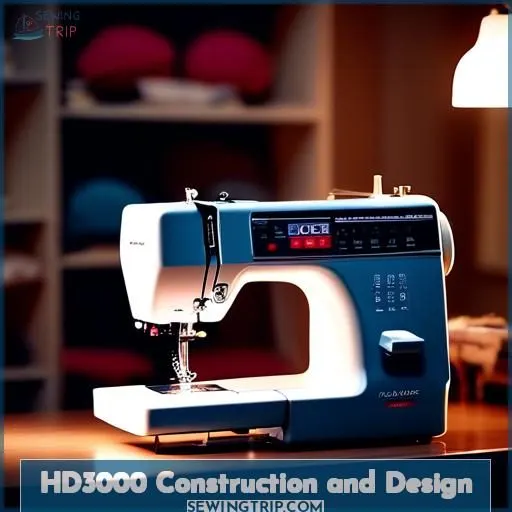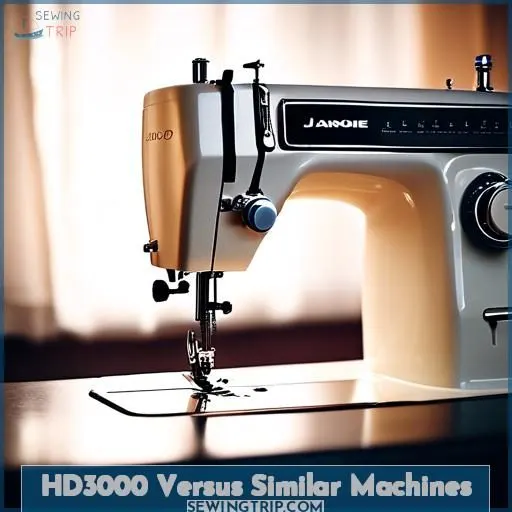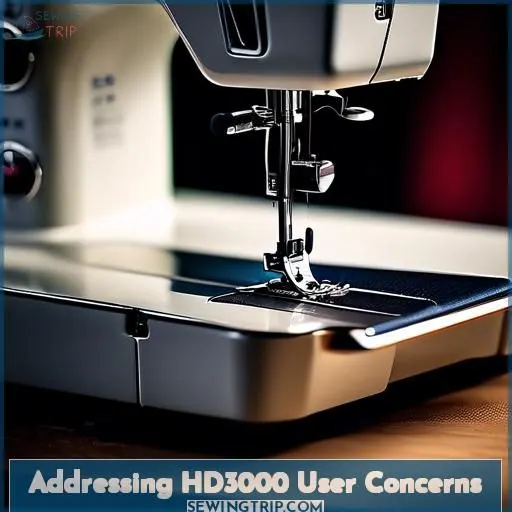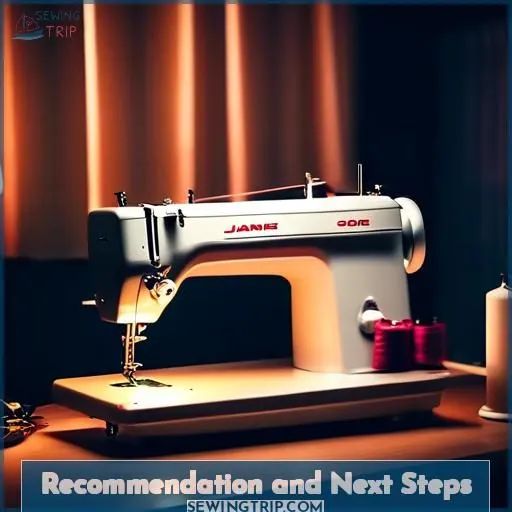This site is supported by our readers. We may earn a commission, at no cost to you, if you purchase through links.
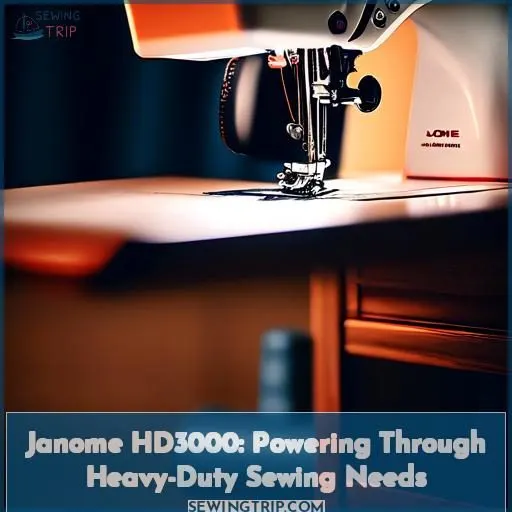
The Janome HD3000 is a heavy-duty sewing machine that has long been a reliable choice for tackling ambitious sewing projects. However, recent concerns have arisen over a motor rating discrepancy and the machine’s overall construction.
While the HD3000 boasts an aluminum core, its plastic body panels raise durability doubts. Additionally, the stated 1.0 AMP motor rating appears to differ from the actual 0.5 AMP, sparking worries about overheating risks and the manufacturer’s motives.
As you weigh your sewing needs and options, it’s worth exploring how the HD3000’s performance and longevity may have been impacted. Delving deeper can help you determine if this machine still meets your stitching requirements.
Table Of Contents
Key Takeaways
- The Janome HD3000’s motor rating has been reduced from 1.0 AMP to 0.5 AMP, raising concerns about performance and potential overheating risks.
- The machine’s plastic body panels and controls may not meet durability expectations, despite the central core being made of aluminum.
- Alternative sewing machines like the Sailrite LSZ Basic Sewing Machine, used industrial sewing machines, and thick leather sewing machines offer different features and capabilities for sewing projects.
- The HD3000’s durability and performance expectations are influenced by factors such as stitching requirements, presser foot lift, and the machine’s suitability for short sewing spurts.
HD3000 Motor Details
You’ve uncovered a discrepancy between the stated and actual motor ratings for your Janome HD3000 sewing machine. This motor change from the original 1.0 AMP to the current 0.5 AMP raises concerns about potential overheating risks and the manufacturer’s motives behind the specification update.
Stated Vs. Actual Motor Ratings
When purchasing the Janome HD3000, you expected a heavy-duty machine with a 1.0 AMP motor. However, the machine’s label indicates a 0.5 AMP motor, which has left you with doubts about its performance. Here are three key points to bear in mind:
- Motor Specifications: The HD3000’s motor rating is lower than anticipated, which may affect its power and efficiency.
- Motor Performance: A 0.5 AMP motor may not provide the same force as a 1.0 AMP motor, potentially impacting the machine’s performance.
- Motor Reliability and Longevity: The motor’s longevity and reliability could be affected by the deviation in specifications, potentially leading to overheating issues and diminished performance.
Implications of Motor Change
The motor change in the Janome HD3000 from a 1.0 AMP motor to a 0.5 AMP motor has significant implications for the machine’s performance and durability. The 0.5 AMP motor has been introduced as a cost-saving measure, potentially impacting energy efficiency and longevity. Some users have reported that the new motor doubles the risk of overheating, raising concerns about the motives behind the change. The HD-5000 also uses a 0.5 AMP motor, and the claimed torque equivalence at the same speed has been questioned, leading to negative online reviews since the motor change.
The 0.5 AMP motor may have been introduced as part of a planned obsolescence strategy or to improve energy efficiency, but the lack of clear communication from Janome about the change has left users feeling misled. The motor change has also impacted the machine’s reputation, with some users expressing disappointment and considering returning the HD3000.
For users seeking a machine with similar capabilities, alternatives at a similar price point include the Sailrite LSZ Basic Sewing Machine, used industrial sewing machines like the Singer 111W and Juki 562/563, and thick leather sewing machines such as the Cowboy CB3200. It’s essential to think about the specific requirements of the sewing project when selecting a machine, including the type of fabric, stitching requirements, and the user’s experience level.
HD3000 Construction and Design
The Janome HD3000 may not have a fully aluminum body as claimed, but its central core is made of aluminum. While the plastic body panels and controls may raise some durability concerns, the HD3000 is still designed to handle heavy-duty sewing tasks with its sturdy internal construction.
Aluminum Core Vs. Plastic Body
As a first-time machine purchaser, you’ve chosen the Janome HD3000, a simple mechanical machine with heavy-duty capabilities. The machine is black, and you’ve been disappointed by its durability. You’ve noticed that the central core of the machine is aluminum, but the body panels and controls are plastic. This has led to concerns about the machine’s performance and longevity.
The aluminum core is indeed a part of the machine, but it’s not the entire body. The central core is made of aluminum, but the body panels and controls are made of plastic. This is a common design choice in sewing machines, as it allows for a balance between durability and weight. The plastic parts are designed to be robust and can withstand the rigors of sewing, especially when combined with the aluminum core.
However, your experience with the HD3000 has been less than satisfactory. The plastic parts haven’t lived up to your expectations, and you’ve noticed that the machine’s durability isn’t as high as you’d hoped. This is a common issue with sewing machines, as the balance between durability and weight can be challenging to achieve.
If you’re looking for a machine with a more robust construction, you might consider machines like the Sailrite LSZ Basic Sewing Machine, which is designed for heavy-duty sewing needs. It has a sturdy build and is capable of sewing through thick materials. Another option is the Singer 111W, which is known for its durability and performance.
Durability and Performance Expectations
When purchasing a sewing machine, durability and performance expectations play a significant role in your decision-making process. The Janome HD3000, with its simple mechanical design and heavy-duty capabilities, is a popular choice for many sewers. However, concerns about the motor’s accuracy and the machine’s actual durability have arisen, which may impact your confidence in the HD3000’s performance.
Motor discrepancies can be frustrating, especially when online sources indicate a higher motor rating than the label on the machine suggests. In the case of the HD3000, the motor is listed as 0.5 AMP, but some sources suggest it was previously 1.0 AMP. This change may be due to an LED work light upgrade, but the reasoning behind it isn’t entirely clear. Doubts about the motor’s performance and potential cost savings or planned obsolescence may influence your decision to keep or return the machine.
To address these concerns, it’s crucial to mull over alternative machines that may better suit your needs. For example, the Sailrite LSZ Basic Sewing Machine is suitable for leather projects, while used industrial sewing machines like the Singer 111W and Juki 562/563 offer more robust construction. Thick leather sewing machines, such as the Cowboy CB3200, may also be worth examining.
When choosing a machine, consider factors like stitching requirements, the need for a high presser foot lift, and the ability to handle short sewing spurts. Vintage machines can be appealing, but their limited capabilities may not meet your expectations. For instance, the Singer 201 presser foot doesn’t lift high enough for handbags, and vintage machines may not have the necessary features for your sewing projects.
HD3000 Versus Similar Machines
In comparison to other sewing machines within its price range, how does the Janome HD3000 measure up? Although the HD3000 boasts noteworthy attributes, there might be viable options available at a comparable cost that merit consideration for your sewing requirements.
Comparison to Other Janome Models
When evaluating the Janome HD3000, it’s crucial to examine the distinctions between this model and comparable machines. Here are four pivotal points to contemplate:
- Motor claims: Online sources suggest that the HD3000 features a 1.0 AMP motor, however, the true motor rating is 0.5 AMP. This disparity could be attributed to alterations in the motor or the machine’s design.
- Durability doubts: The HD3000’s exterior is composed of plastic panels and controls, which may raise concerns about its longevity. Users have reported challenges with the machine’s performance, especially when compared to earlier Janome models constructed with more durable materials.
- Plastic panels: While the HD3000’s core is aluminum, its body panels and controls are fabricated from plastic. This may affect the machine’s overall stability and performance.
- Comparison options: When evaluating the HD3000, it’s prudent to explore other Janome models, such as the HD-5000, which also employs a 0.5 AMP motor. This can assist you in comprehending how the HD3000 compares to other alternatives within the Janome lineup.
Alternatives at Similar Price Points
If you’re looking for a sewing machine that can handle thick leather and is within your budget, there are several options to examine. While the Janome HD3000 is a good choice for sewing leather, it’s critical to contemplate other machines that can meet your requirements.
For example, the Sailrite LSZ Basic Sewing Machine is a suitable option for those who sew leather regularly. It’s engineered to handle thick leather and is a good choice for leather projects such as saddles. However, it may not be as suitable for sewing in short spurts as the HD3000.
Another option is the Singer 111W, which is a used industrial sewing machine that can handle thick leather. It’s known for its durability and is often recommended for leather projects. Additionally, the Juki 562 and Juki 563 are also suitable for thick leather sewing, and they can be found at a similar price point.
If you’re open to considering used industrial sewing machines, there are several options available that can handle thick leather. These machines are often more robust and durable than home sewing machines, making them suitable for heavy-duty leather projects.
Addressing HD3000 User Concerns
The reduction in the motor’s amperage on the Janome HD3000 has raised some concerns about potential overheating risks and suspicions about the manufacturer’s motives, such as cost savings or planned obsolescence. While these are valid concerns, it’s important to examine the details and implications more closely to determine if they truly impact the machine’s performance and durability.
Overheating Risks
With the HD3000’s motor change from 1.0 AMP to 0.5 AMP, concerns about motor performance and equivalence arise. The torque claims at the same speed are questioned, and the energy efficiency or planned obsolescence is suspected. The overheating risk is also doubled, which may impact the machine’s durability and reliability.
Suspected Motives for Motor Change
You’re not alone in your concerns about the Janome HD3000’s motor change. Here are three reasons why you might be feeling this way:
- Planned Obsolescence: Some users suspect that the change was a deliberate move to make the old model obsolete.
- Cost Savings: A lower-powered motor could mean lower production costs for Janome.
- Energy Efficiency: The company might’ve aimed to make the machine more energy-efficient, but this hasn’t been clearly communicated.
These factors, combined with the perceived lack of torque equivalence at the same speed and negative online reviews since the motor change, have left many users feeling let down.
Recommendation and Next Steps
You have some valid concerns about the Janome HD3000, but don’t be too quick to return it. Consider whether the machine still meets your needs, or explore alternative options that may better suit your heavy-duty sewing requirements and budget.
Potential Return or Keeping the HD3000
You’ve invested in a Janome HD3000, a machine that was initially purchased for its heavy-duty capabilities and simple mechanical design. However, you’ve encountered motor discrepancies, which have led to doubts about the machine’s durability. The online sources indicate a 1.0 AMP motor, but the label on the machine states a 0.5 AMP motor, and customer support has confirmed the 0.5 AMP motor. This change was cited as a reason for the LED work light upgrade, but no clear explanation was provided. This has left you with concerns about the motor’s performance and potential overheating risks.
Given these issues, you’re considering returning the machine or keeping it. If you decide to keep it, you’re looking for suggestions for suitable machines at a similar price point. You’ve mentioned that you prefer machines with strong stitching from the first stitch, can’t take running starts on bags, find topstitching difficult without a running start, and require a high presser foot lift. You’ve also expressed a preference for machines that can handle short sewing spurts.
To help you make an informed decision, it’s necessary to understand the implications of the motor change and the potential reasons behind it. If the 0.5 AMP motor is indeed a cost-saving measure, energy efficiency, or planned obsolescence, it could impact your decision to keep the machine. Additionally, you’ll want to consider the negative online reviews since the 0.5 AMP motor was introduced.
If you decide to return the HD3000, you’ll need to explore alternative machines that meet your requirements. This might include machines with a similar price point, such as the Sailrite LSZ Basic Sewing Machine, used industrial sewing machines like the Singer 111W or Juki 562, or thick leather sewing machines like the Cowboy CB3200.
Ultimately, your decision will depend on your specific sewing needs, the machine’s performance, and your comfort with the motor discrepancy. It’s important to weigh the advantages and disadvantages of each option and consider your personal preferences and experiences with the HD3000.
Suggestions for Suitable Machines
When contemplating switching out your Janome HD3000 sewing machine, it’s crucial to run a cost-benefit analysis to guarantee you’re getting the best pick for your requirements. Here are some proposals for suitable machines at a comparable price point:
-
Sailrite LSZ Basic Sewing Machine: This machine is appropriate for leather and has a robust stitching ability. It could be a worthy alternative if you’re in the market for a machine that can take on thicker materials.
-
Second-hand Industrial Sewing Machines: These machines are frequently more robust and can handle heavy-duty chores. You can uncover them at a lower cost than new machines, making them a cost-effective option.
-
Thick Leather Sewing Machines: Machines like the Cowboy CB3200 are engineered specifically for thick leather and may be a wiser choice if you’re working with heavy-duty materials.
-
Singer 111W: This machine is an industrial-style machine that can handle thicker materials and has a robust stitching ability. It could be a worthy alternative if you’re in the market for a machine that can take on heavy-duty chores.
-
Juki 562/563: These machines are also industrial-style machines that can handle thicker materials and have a robust stitching ability. They could be a worthy alternative if you’re in the market for a machine that can take on heavy-duty chores.
-
Vintage Machines: If you fancy the feel and appearance of vintage machines, you might deliberate trying out a Singer 201 presser foot. While it doesn’t elevate sufficiently for handbags, it could be a worthy option for other projects.
Keep in mind to deliberate the machine’s capabilities, stitching strength, and presser foot lift when making a choice on a replacement. It’s also crucial to peruse user reviews and consider the enduring value of the machine.
Frequently Asked Questions (FAQs)
What is the warranty period for the Janome HD3000 sewing machine?
You’ll be pleased to know the Janome HD3000 comes with a 25-year limited warranty. This robust coverage reflects the machine’s solid construction and Janome’s confidence in its durability. Rest assured, you’re well-protected.
Can the Janome HD3000 handle sewing thick leather?
Unfortunately, the Janome HD3000 isn’t well-suited for sewing thick leather. Its lightweight motor and limited presser foot clearance make it better suited for lighter fabrics. You may wish to think about an industrial sewing machine for that task instead.
How does the Janome HD3000 compare to other similar sewing machines in terms of durability and performance?
The Janome HD3000 holds its own in the budget sewing machine market, though durability may fall short of industrial-grade options. Its solid performance surprised you, but longevity concerns persist. Consider your needs – the HD3000 may still fit the bill.
Is the Janome HD3000 suitable for sewing jeans?
While the Janome HD3000 isn’t the top choice for sewing thick denim, it can handle lighter jeans fabrics reasonably well with the right needle and thread. Just don’t expect it to power through heavy-duty seams without struggle.
What are the common issues reported by users with the Janome HD3000?
Based on user reports, common Janome HD3000 issues include a weaker 5 AMP motor, durability concerns over the plastic body, and challenges sewing thick fabrics like leather. However, many still find it a capable entry-level machine.
Conclusion
Consider the case of Sam, a diligent seamstress who recently purchased the Janome HD3000 sewing machine to tackle her ambitious quilting projects. While the HD3000’s aluminum core initially inspired confidence, Sam’s concerns grew after discovering the discrepancy between the stated and actual motor ratings.
Ultimately, you’ll need to weigh the Janome HD3000’s pros and cons against your specific sewing needs. If the motor rating issue is a dealbreaker, exploring alternative heavy-duty machines in a similar price range may be your best path forward.

